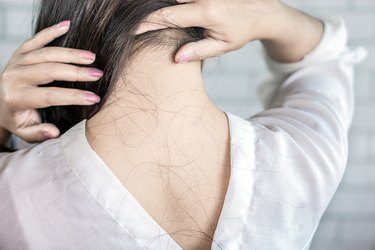
One way you might be squeezing more time out of your day is by skipping the whole shampoo and styling rigamarole post-workout, in favor of a quick shower or a few spritzes of dry shampoo and a swipe of deodorant.
After all, shaving off 15 minutes can make all the difference if you have to rush to work right afterward, pick up the kids or get dinner on the table at a reasonable hour.
Video of the Day
Video of the Day
But it turns out that lingering perspiration is less than ideal for your skin and hair. Here, dermatologists give the scoop on what can happen if you don't suds up your sweaty strands.
You Can Get Dandruff

When sweat dries on your scalp, it creates a film on top of your skin. Left to stew for too long, that can lead to seborrheic dermatitis, a fungal infection "more commonly known as good old dandruff," says Sapna Palep, MD, a board-certified dermatologist and founder of Spring Street Dermatology in New York City.
"It's a natural condition that we all have to a certain degree, but buildup from sweat and oil creates a perfect breeding ground, and the fungus over-colonizes," she says.
Seborrheic dermatitis can also appear as scaling and redness elsewhere on your body if you don't shower after a workout. "It affects areas where sebum or the oils of the skin are produced, including the eyebrows, around the nose, the mid-chest and, in severe cases, the forehead and chin," says Amy McMichael, MD, chair of the dermatology department at Wake Forest University Health Sciences.
For some people, hot summer temperatures exacerbate seborrheic dermatitis because the heat can lead to extra scalp sweat, especially if you're exercising under sunny skies instead of in an air-conditioned gym. For others, it flares up in the winter. "This might be because less humid weather in the winter dries out the skin and increases irritation," Dr. McMichael says.
If you tend to sweat a lot during your workouts, it's best to make time to shower and wash your hair in order to prevent dandruff. If you don't sweat much, you can shampoo two to four times a week, depending on how oily your hair is.
"Use a gentle formula, and focus only on the scalp," Dr. Palep says. "The shampoo that will naturally run off your scalp when you're rinsing is enough to cleanse the rest of your hair."
If you're already dealing with seborrheic dermatitis or are prone to dandruff, an antifungal shampoo can help. "Try Selsun Blue ($9.28, Amazon.com), which has selenium sulfite, or Head & Shoulders ($12.96 for 2, Amazon.com) with pyrithione zinc," Dr. Palep says. "Another option is a clarifying tea tree shampoo, as long as it doesn't contain tea tree oil, which will further clog your scalp."
Use it every time you wash until the flaking is under control, and your scalp no longer feels itchy or inflamed. At this point, you might be able to use it only once a week. Keep in mind that seborrheic dermatitis is chronic, so it probably won't disappear right away.
One caveat: Only wash coily or kinky hair once a week, even if you work up a serious sweat. "Shampoo is designed to strip oils from the hair, which tightly curled hair desperately needs," says Crystal Aguh, MD, assistant professor of dermatology at Johns Hopkins School of Medicine, member of the board of directors of the Skin of Color Society and author of 90 Days to Beautiful Hair. Soaping up more frequently can damage your hair.
Tip
Before you shampoo, apply conditioner to the ends of your hair, so they don't get dried out. This is especially important for color-treated hair, which is more brittle, as well as coily or kinky hair. (Tight curls mean natural scalp oils won’t travel down your hair shaft as easily, so your scalp might feel greasy even if the rest of your mane is like the Sahara.)
You Might Lose Some Hair
The itchiness and flaking associated with seborrheic dermatitis are annoying, but if you don't nip them in the bud, you could have bigger problems to contend with, including thinning hair.
"When there are visible flakes on your scalp, that means the fungus has invaded the superficial layers of your skin, and this causes hair shedding," Dr. Palep says. "What's more, the buildup jams up your hair follicles, slowing down or preventing new growth."
In addition to hair loss, seborrheic dermatitis may result in skimpier strands and less shine, according to a December 2018 study in the International Journal of Trichology. Translation: Dull, lifeless locks.
While washing more often and using a medicated shampoo can help keep hair loss at bay, shampooing too frequently might lead to a thinning mane as well. "It dries the hair shafts and causes breakage," Dr. McMichael says. "There is no perfect amount of washing."
Rather, the trick is to find your own sweet spot. "For those with very kinky hair, shampooing weekly or every other week can suffice," Dr. McMichael says. "For those with very fine hair and oily scalp, daily washing may work best."
No matter what your hair type, use a gentle shampoo and conditioner that won't dry out your hair and strip its healthy oils. "Shampoos with harsh ingredients, like sodium lauryl sulfate, can lead to hair breakage," Dr. Aguh says.
"People who exercise often should use a mild sulfate-containing shampoo with ingredients, such as C14-16 olefin sulfonate, followed by a deep conditioner once a week," she says. Dr. McMichael also recommends selecting a deep conditioner that contains a silicone to coat and protect hair shafts.
Tip
Tying your hair too tight in a ponytail or bun for your workouts can contribute to hair loss. "Hairstyles that put significant tension on the hair follicle can lead to traction hair alopecia in those who are susceptible to this condition," Dr. McMichael says. Instead of an elastic band, opt for a coated ponytail holder or wear a loose braid along with a headband — and take down your hair as soon as you're done exercising.
You Could Be More Prone to Infection

Another reason to wash your hair after a really sweaty workout: Seborrheic dermatitis can be itchy, and some people end up scratching so much that their scalp bleeds. Yikes!
"A lot of people scratch at night and don't even realize they are doing it," Dr. Palep says. "These abrasions increase your risk of bacterial and fungal infection."
In order to prevent infection, you need to address the root of the problem by alleviating those flakes and scales, Dr. Palep says. "Treatment varies based upon severity of disease," Dr. McMichael adds. "Some patients improve with anti-dandruff shampoos alone." Try one that has an active anti-inflammatory or anti-yeast ingredient, such as zinc, ketoconazole, tar, selenium sulfide or ciclopirox.
"There are also zinc-containing scalp treatments that can be applied to the scalp between shampoos," Dr. McMichael says. Or, on non-shampoo days, you can "co-wash" your hair with an anti-dandruff conditioner — simply apply it to your scalp in the shower and then rinse it off.
Finally, it's important to resist the temptation to scratch. "Scraping the scales on the scalp can worsen the condition," Dr. McMichael says.
If you've tried all that and are still itchy and uncomfortable, make an appointment with a dermatologist. Your doc may recommend a regimen of medicated shampoo and/or other topical or oral meds, Dr. McMichael says.
Related Reading
You Can Get 'Scalpne'
People who habitually don't shampoo after a sweaty workout might detect pimple-like bumps on their scalp — or scalpne — technically called folliculitis. "Folliculitis is inflammation of the hair follicles," Dr. McMichael says. "If not treated, it can lead to localized scarring and hair loss."
Since folliculitis is a component of seborrheic dermatitis, the treatment is the same: Wash your hair appropriately for your hair type, using a gentle medicated shampoo. "If pustules are resistant to this treatment, topical antibiotic solutions can be used," Dr. McMichael says. In rare instances, your dermatologist might prescribe a short course of an oral antibiotic.
It also helps to take note of whether any of your hair products seem to be aggravating your folliculitis. If they do, steer clear of them.
For example, some people find that hair oils and butters are problematic. "Occlusive pomades can also cause folliculitis if used too frequently," Dr. McMichael says. "In addition, many people have allergic reactions to certain components in hair products, including fragrances, which can cause irritation of the scalp that manifests as pustules."
Tip
Your menstrual cycle can also play a role in developing seborrheic dermatitis. “It may worsen before your period when your hormones trigger an uptick in oil production,” Dr. Palep says.
Plus, stress can make your dandruff worse and cause excess oil buildup. “Stress leads to the release of the hormones cortisol and testosterone, both of which increase sebum production and result in more oil on your scalp,” Dr. Palep says.
When to Use Dry Shampoo
On busy days, you might be wondering whether you can just spray on a little dry shampoo after getting your cardio fix and then be on your way.
Dermatologists say that as long as your scalp is flake-free, you can occasionally use it to buy yourself a day sans shampoo. But don't put it on multiple days in a row or it will create buildup. Dr. Palep says she has seen patients with an inch thick of residue on their scalp from overuse of dry shampoo.
"In addition, frequent use can cause scalp irritation, dry the hair shafts and exacerbate inflammatory scalp conditions like seborrheic dermatitis," Dr. McMichael says. So skip dry shampoo altogether if you do have dandruff.
And remember that even though it's called dry "shampoo," it doesn't actually clean your scalp or hair. "Dry shampoo usually contains a starch product that absorbs oils," Dr. McMichael says. "This can allow the hair and scalp to appear less greasy and smell fresh, but it does not cleanse the scalp or hair."
According to the Cleveland Clinic, washing and rinsing with wet shampoo is still necessary for removing dirt, bacteria and yeast.
How to Use Dry Shampoo Correctly
"Spray it onto the scalp and then gently brush or comb through the hair to absorb the oils," Dr. McMichael says. Brushing it through your strands helps distribute the product so it won't build up as much on your scalp.
So, How Bad Is It Really to Not Shampoo After Exercising?
If you only sweat a little, then washing your hair after every workout is unnecessary. When you're on the go, you can sparingly apply dry shampoo to soak up oil. If you have coily or kinky hair, you should only wash once a week anyway.
But if you sweat a lot after your workout, it's best to wash your hair as soon as possible to avoid a buildup of film on your scalp that could lead to seborrheic dermatitis, hair thinning or infection.
"Shampooing after workouts is really a question of aesthetics and personal preference," Dr. Aguh says. "But washing and conditioning the hair on a regular basis, with the right products, is critical to maintaining beautiful, healthy hair."
If you are prone to dandruff, use a gentle, antifungal shampoo made with ingredients like selenium sulfite or pyrithione zinc to fight the inflammation. You should also avoid dry shampoos and shampoos made with harsh fragrances, which can further irritate your scalp.
Related Reading
Was this article helpful?
150 Characters Max
0/150
Thank you for sharing!
Thank you for your feedback!
